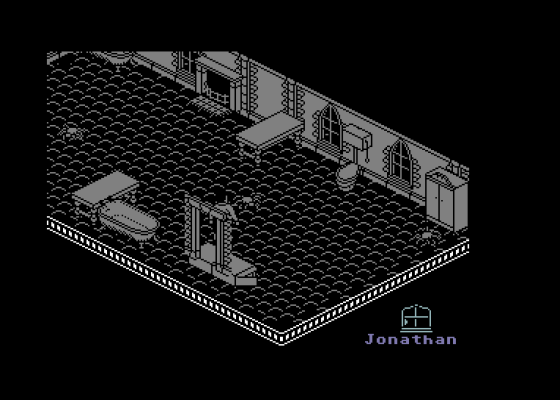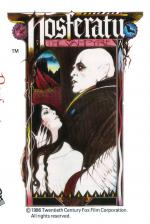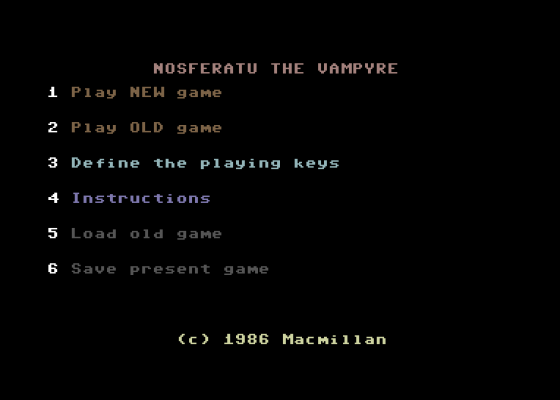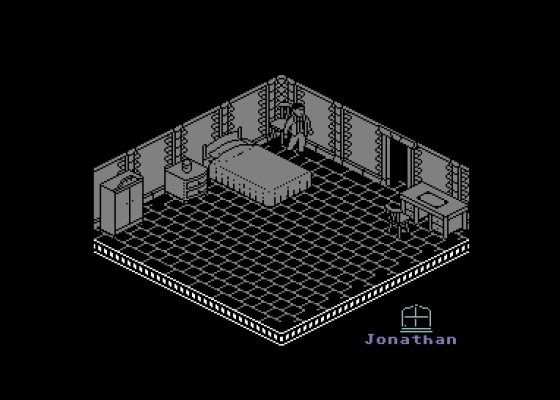
Commodore User
 1st February 1987
1st February 1987
Categories: Review: Software
Author: Byll Scolding
Publisher: Piranha
Machine: Commodore 64
Published in Commodore User #42
Nosferatu The Vampire
Just as soon as this game is loaded you'll get a heady whiff of embalming fluid. Yes, the gang at Design Design has resurrected that old and trusty servant Filmation from the crypt, dusted off the cobwebs, and found him gainful employment in Piranha's latest offering, Nosferatu The Vampire. The question is, does the old beggar still have any life left in him? Nosferatu The Vampire is based on the film of the same name by Werner Herzog, a brilliant director but lousy speller. It follows the film as closely as a computer can - i.e. not very close at all - and breaks the action down into three sections: Dracula's Castle, The Town of Wismar, and Lucy's House. Some measure of success is needed in each to enable you to load the code for the next.
Part one features Jonathan Harker, a lowly rep for a firm of estate agents, who discovers that the would-be purchaser of a charming two-bed semi (with patio and c/h) is none other than Nosferatu, aka Count Dracula. If the sale goes ahead, the Count will transform the good citizens of Wismar into blood-sucking parasites. Worse, he will cause house prices to tumble!
In an act uncharacteristic of estate agents, Jonathan decides to forgo his agent's commission, and resolves to steal the deeds to the property from Nosferatu's castle, and this is where we find him at the beginning, standing alone in an opulent bedroom on the first floor.

The perspective graphics, 3D and limited colour are immediately familiar, but are nevertheless very impressive. An imposing stairway sweeps from the minstrels' gallery above to the spacious hall below. The dining room is decked out in oak panelling, candelabras and ancestral portraits, and in the library, lined with books and sliding step-ladders, the desks even have individual blotters. Everything combines to create a realistic, atmospheric setting.
Beneath this splendour, however, drifts the stench of decay. Rats swarm the kitchen, bloated spiders scuttle scross the bathroom tiles, bats flit back and forth in the hall. As Jonathan descends to the cellar, the infestation increases, until he can hardly move for vermin underfoot (actually, he can hardly move because of the number of animated sprites on the screen at one time, a common feature of games of this type).
Searching the castle, and dealing with the creatures which infest it, takes many moons, and the passing of night and day can be seen in a window icon at bottom right (there doesn't seem to be any time limit though). Every room is furnished with likely-looking hiding places. Guns are found in drawers, lamps on tables, swords hang on walls, and there is even a pair of Doc Martens lurking behind the bog.

While some morsels can be found in the bedrooms and ante-rooms, most food is, not surprisingly, stored in the dining room and kitchen, where Jonathan will need it after a savage confrontation with the vampire bats in the hall.
There's also at least one secret room to find, as well as a secret passage to the cellars. And even if Jonathan can find the latter, he won't get very far in the pitch darkness without a lit lamp. Locating the matches is almost as difficult as tracking down the deeds. All this would be practically impossible if it were not for the Save Game option on the menu, enabling you to avoid starting afresh every time Jonathan's energy runs out.
Sooner or later Jonathan will find and unlock the main door, with or without the precious deeds, and we're into the second section. He descends the stairway to the street, smug at his escape, and is completely unprepared for the shock that follows.

The entire male population of Wismar consists of estate agents, all looking exactly like himself.
Not only that, but the women who glide about the cobbles are all the spitting image of hiis wife, Lucy. Sinister though this may seem, it has, in fact, absolutely nothing to do with the plot, but is an economy forced upon the programmers by memory restrictions. Whatever the excuse, it makes the task of moving your characters frustrating at times.
Gameplay is in any case more complicated now. Instead of just Jonathan, you've also got Lucy and her admirer, Van Helsing, to control, switching between them by selecting keys 1, 2 or 3. The idea is to keep Lucy safe from the rats and vampires until she can lure Nosferatu to her house.

If the Count still has the deeds to his desirable bijou residence, then he has a safe base from which to operate. Otherwise he is forced to roam the streets and seek shelter at dawn, though he might attempt to recover the lost documents from Jonathan's ex-boss, locked away in a mad-house.
And while all this is going on, the Wismar townsfolk are gradually succumbing to Nosferatu's power. Jonny and Van Helsing mush dash about scattering garlic in all directions, and carving up any furniture to hand to provide a plentiful supply of stakes. No picnic. Extremely difficult, strong on plot, and visually stunning - what more could you want? Well, a few more puzzles for a start - puzzles which actually demand some kind of logical or lateral thinking. To find the secret passage Jonathan walks around a room banging his head against the wall until it lets him in. Where's the skill in that?
The occasional slice of zapping wouldn't go amiss, either. Those bat attacks would be a darn sight more interesting if Jonathan was seen to be wildly waving his sword about, rather than standing there like a dummy.
Minor criticisms perhaps, but for a Filmation-type game to get to the top of the tree these days it's got to be just about perfect. Nosferatu doesn't quite make it.
Scores
Commodore 64 Version| Graphics | 70% |
| Sound | 50% |
| Toughness | 80% |
| Endurance | 80% |
| Value For Money | 80% |
| Overall | 80% |





